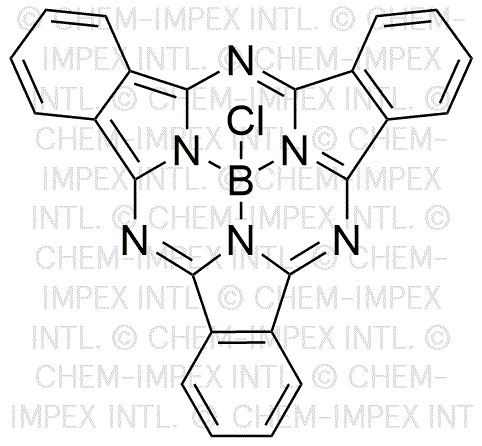Boron subphthalocyanine chloride is widely utilized in research focused on:
- Photodynamic Therapy (PDT): This compound is effective in treating certain cancers by producing reactive oxygen species when exposed to light, helping to destroy cancer cells while minimizing damage to surrounding healthy tissue.
- Solar Energy Conversion: It serves as a promising material in organic photovoltaics, enhancing the efficiency of solar cells by improving light absorption and charge transport.
- Fluorescent Probes: Used in biological imaging, it acts as a fluorescent marker, allowing researchers to visualize cellular processes and structures in real time.
- Electronics: Its unique electronic properties make it suitable for applications in organic light-emitting diodes (OLEDs), contributing to the development of more efficient and vibrant display technologies.
- Nanotechnology: The compound is explored for use in drug delivery systems, where its ability to form stable complexes can enhance the targeted delivery of therapeutic agents to specific cells or tissues.
General Information
Properties
Safety and Regulations
Applications
Boron subphthalocyanine chloride is widely utilized in research focused on:
- Photodynamic Therapy (PDT): This compound is effective in treating certain cancers by producing reactive oxygen species when exposed to light, helping to destroy cancer cells while minimizing damage to surrounding healthy tissue.
- Solar Energy Conversion: It serves as a promising material in organic photovoltaics, enhancing the efficiency of solar cells by improving light absorption and charge transport.
- Fluorescent Probes: Used in biological imaging, it acts as a fluorescent marker, allowing researchers to visualize cellular processes and structures in real time.
- Electronics: Its unique electronic properties make it suitable for applications in organic light-emitting diodes (OLEDs), contributing to the development of more efficient and vibrant display technologies.
- Nanotechnology: The compound is explored for use in drug delivery systems, where its ability to form stable complexes can enhance the targeted delivery of therapeutic agents to specific cells or tissues.
Documents
Safety Data Sheets (SDS)
The SDS provides comprehensive safety information on handling, storage, and disposal of the product.
Product Specification (PS)
The PS provides a comprehensive breakdown of the product’s properties, including chemical composition, physical state, purity, and storage requirements. It also details acceptable quality ranges and the product's intended applications.
Certificates of Analysis (COA)
Search for Certificates of Analysis (COA) by entering the products Lot Number. Lot and Batch Numbers can be found on a product’s label following the words ‘Lot’ or ‘Batch’.
Número de catálogo
Número de lote/lote
Certificates Of Origin (COO)
This COO confirms the country where the product was manufactured, and also details the materials and components used in it and whether it is derived from natural, synthetic, or other specific sources. This certificate may be required for customs, trade, and regulatory compliance.
Número de catálogo
Número de lote/lote
Safety Data Sheets (SDS)
The SDS provides comprehensive safety information on handling, storage, and disposal of the product.
DownloadProduct Specification (PS)
The PS provides a comprehensive breakdown of the product’s properties, including chemical composition, physical state, purity, and storage requirements. It also details acceptable quality ranges and the product's intended applications.
DownloadCertificates of Analysis (COA)
Search for Certificates of Analysis (COA) by entering the products Lot Number. Lot and Batch Numbers can be found on a product’s label following the words ‘Lot’ or ‘Batch’.
Número de catálogo
Número de lote/lote
Certificates Of Origin (COO)
This COO confirms the country where the product was manufactured, and also details the materials and components used in it and whether it is derived from natural, synthetic, or other specific sources. This certificate may be required for customs, trade, and regulatory compliance.


